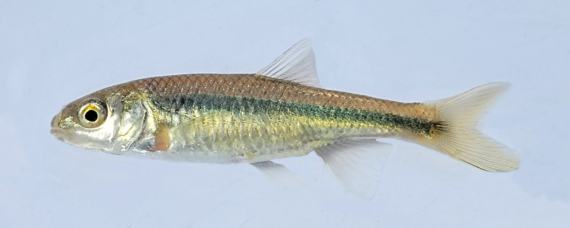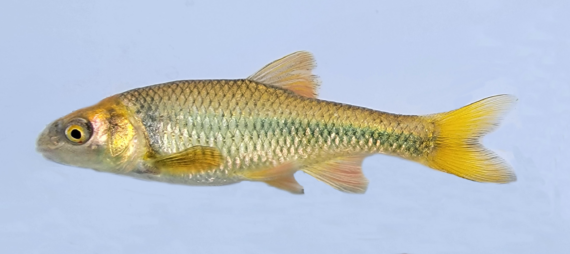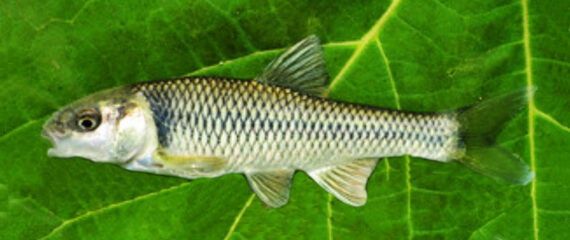Proserpine Shiner, Cyprinella proserpina
 Proserpine Shiner, Cyprinella proserpina, Female. Fish caught from the Pecos River, Peso, Texas, April 2024. Length: 7.6 cm (3.0 inches). Catch, photograph and identification courtesy of Chris Moore, Peoria, Arizona.
Proserpine Shiner, Cyprinella proserpina, Female. Fish caught from the Pecos River, Peso, Texas, April 2024. Length: 7.6 cm (3.0 inches). Catch, photograph and identification courtesy of Chris Moore, Peoria, Arizona.
 Proserpine Shiner, Cyprinella proserpina, Breeding Male. Fish caught from the Pecos River, Pecos, Texas, April 2024. Length: 7.0 cm (2.8 inches). Catch, photograph and identification courtesy of Chris Moore, Peoria, Arizona.
Proserpine Shiner, Cyprinella proserpina, Breeding Male. Fish caught from the Pecos River, Pecos, Texas, April 2024. Length: 7.0 cm (2.8 inches). Catch, photograph and identification courtesy of Chris Moore, Peoria, Arizona.
 Proserpine Shiner, Cyprinella proserpina, Breeding Male. Fish caught from the San Felipe Creek, Del Rio, Texas, June 2023. Length: 7.6 cm (3.0 inches). Catch, photograph and identification courtesy of Chris Moore, Peoria, Arizona.
Proserpine Shiner, Cyprinella proserpina, Breeding Male. Fish caught from the San Felipe Creek, Del Rio, Texas, June 2023. Length: 7.6 cm (3.0 inches). Catch, photograph and identification courtesy of Chris Moore, Peoria, Arizona.
 Proserpine Shiner, Cyprinella proserpina. Fish caught from Sandy Creek, Henry, Illinois, August 2014. Length: 9.0 cm (3.5 inches). Catch, photograph and identification courtesy of Eli (obsessiveangling.wordpress.com).
Proserpine Shiner, Cyprinella proserpina. Fish caught from Sandy Creek, Henry, Illinois, August 2014. Length: 9.0 cm (3.5 inches). Catch, photograph and identification courtesy of Eli (obsessiveangling.wordpress.com).
The Proserpine Shiner, Cyprinella proserpina, is a member of the Carp and Minnow or Cyprinidae Family, and is known in Mexico as carpita del Norte and the carpita de río norteña. Globally, there are thirty-two species in the genus Cyprinella, of which eight are widespread throughout Mexico’s freshwater systems.
The Proserpine Shiner has a fairly deep laterally compressed body that are deepest anterior of the dorsal fin origin. They are dusky olive to blue dorsally transitioning to silvery on their sides and to white ventrally. They have a dark stripe that runs from the chin to the throat and a dark bar about the pectoral fin base. When breeding, males develop a brassy yellow head with a blue-black bar on their sides behind the head and orange fins with white margins. Their head is rounded and compressed with mid-sized eyes and a slightly sub-terminal mouth. Their anal fin has 8 rays; their caudal peduncle is wide; their caudal fin is concave with wide lobes; their dorsal fin has less than 10 rays; and their pectoral fins have 13 rays.
The Proserpine Shiner is a non-migrant mid-water schooling freshwater species found in clear streams, spring-fed tributaries and spring runs that have aquatic vegetation and algal growth. They reach a maximum of 7.5 cm (2.95 inches) in length. They feed on a wide variety of aquatic insects. The Proserpine Shiner is poorly studied with very limited information available about their lifestyle and behavioral patterns including specific details on age, growth, longevity, movement patterns, diet, habitat use, and reproduction.
The Proserpine Shiner is native to the freshwater systems of northern mainland Mexico being limited to the Atlantic slope of the Río San Carlo of the Río Grande drainage in the State of Coahuila.
The Proserpine Shiner can be easily confused with the Plateau Shiner, Cyprinella lepida and the Red Shiner, Cyprinella lutrensis (both lack a black stripe on the chin and throat stripe on sides, terminal mouths and red or orange fins).
From a conservation perspective the Proserpine Shiner is currently considered to be of Least Concern with stable widely distributed populations. Their long-term survival is threatened by changes in water quantity and quality with pollution caused by human development and the introduction of foreign taxa including Armored Catfish, Blue Tilapia and Smallmouth Bass. They are intolerable of high salinity waters. The Prosperpine Shinner is a component of the aquarium trade.